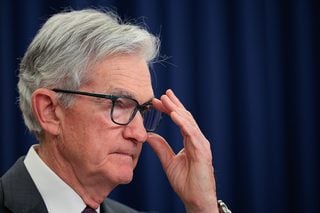Fed Chair Powell Hints at Possible Incoming Rate Cut
NerdWallet Economist Elizabeth Renter weighs in on Powell’s rate cut signal.

Many, or all, of the products featured on this page are from our advertising partners who compensate us when you take certain actions on our website or click to take an action on their website. However, this does not influence our evaluations. Our opinions are our own. Here is a list of our partners and here's how we make money.
Federal Reserve Chair Jerome Powell, in a closely watched speech Friday at the Kansas City Fed’s annual conference in Jackson Hole, Wyoming, signaled — gently — that there could be a potential rate cut ahead.
Powell said the current economic conditions — in particular, a stable unemployment rate — enables the Fed to “proceed carefully” in policy decisions moving forward. He added, “With policy in restrictive territory, the baseline outlook and the shifting balance of risks may warrant adjusting our policy stance."
Markets surged following Powell’s speech, with the major stock indexes rising more than 1.5%.

The Fed never makes promises to cut rates before its meetings, but if the FOMC met today, it’s unlikely that a cut would be on the table, says NerdWallet’s senior economist Elizabeth Renter.
“Powell reiterated that softening in the labor market is not indicative of ‘slack’ at this moment. Inflation is still above target and the current rate means policymakers are well positioned to respond in either direction when the data compels them,” says Renter. “But they’re not meeting today and there will be much more data in-hand when they do get together in three weeks.”
Renter says the overall effects of trade and immigration policies remain unclear, even as economic impacts have begun to appear in economic data.
The Fed, in confronting new macroeconomic conditions, is adjusting its policy framework — basically how the Central Bank approaches rate decisions. Framework adjustments are made every five years.
Powell said in his speech that the framework must evolve as the economy changes: “The Great Depression presented different challenges from those of the great inflation and the great moderation, which in turn are different from the ones we face today.”
» MORE: Are we in a recession?
In updating its framework, Renter says, it can incorporate more recent insights, but there’s no certainty that those lessons will hold true under future conditions.
Economic conditions have changed significantly since the previous framework was adopted, says Renter, but the key thing to remember is that the Fed’s mandate doesn’t change even if the Fed’s strategy does.
“Their marching orders are still maintaining stable prices and full employment,” says Renter. “What shifts is how they think about their actions and trade-offs when applying policy to achieve those ends.”
She adds, “Today’s framework revisions were largely focused on clearer communications. The clearer the Fed is about their approach, the more effective they can be in effecting monetary policy.”
The Fed last cut the federal funds rate at its December meeting, lowering its level to 4.25% to 4.50%, where it has remained since. Soon after Powell’s remarks, futures market’s CME FedWatch Tool pegged the probability of a rate cut at the Fed’s Sept. 16-17 meeting at nearly 90%.
(Lead photo by Michael M. Santiago/Getty Images News via Getty Images. Photo of Jerome Powell by Chip Somodevilla/Getty Images News via Getty Images.)
Article sources
NerdWallet writers are subject matter authorities who use primary,
trustworthy sources to inform their work, including peer-reviewed
studies, government websites, academic research and interviews with
industry experts. All content is fact-checked for accuracy, timeliness
and relevance. You can learn more about NerdWallet's high
standards for journalism by reading our
editorial guidelines.
Related articles






